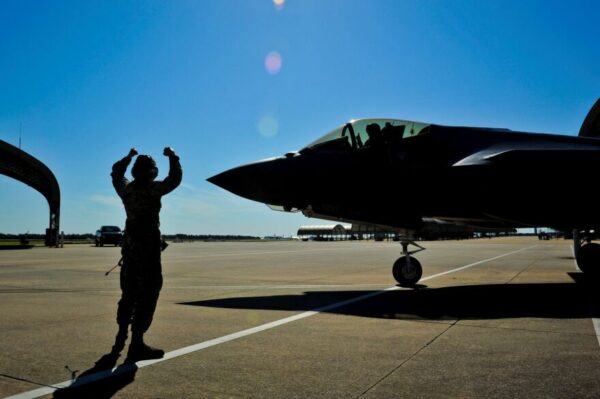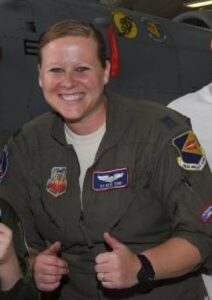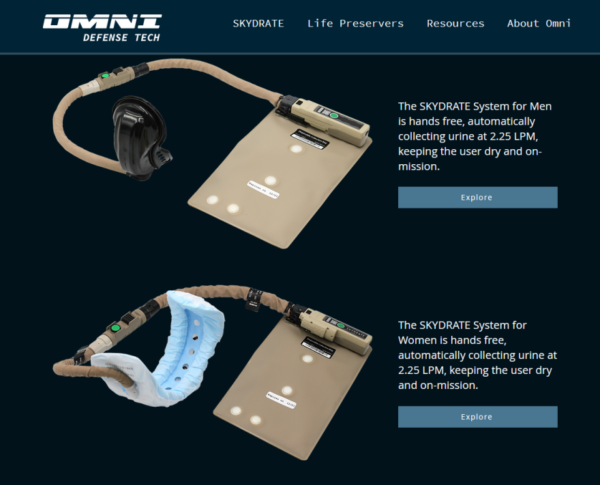
The Air Force has developed a new device to help fighter pilots urinate during long flights. It’s a challenge that pilots stationed overseas often face because they routinely fly missions to faraway destinations. That’s why an Eielson Air Force Base pilot helped test the new in-flight bladder relief system — one that’s designed for women.
It’s one of the most basic human functions. But if you’re a fighter pilot strapped into a cramped cockpit flying at 500 knots and headed into a faraway combat zone, the need to pee can become a major concern.
“It might sound like a weird thing to talk about, but … if you’re so focused on that instead of flying the aircraft, it could be a real hindrance,” says Maj. Nikki Yogi, an F-35 pilot stationed at Eielson Air Force Base.
Yogi knows all about that. Five years ago, when she was a captain flying A-10s, she had a bad experience with an older in-flight bladder relief system that she says was issued a week before deploying overseas. She was able to make it work, with the help of another woman fighter pilot who recognized that the kit was missing some parts.

But still, she says, “It did not go very well.”
Yogi said in a recent interview that she had problems with the device in part because the Air Force has only just begun modifying bladder relief devices that until then had been used almost exclusively by men. She says that’s because until the 1990s, only men were allowed to fly combat missions.
Yogi said the first women fighter pilots didn’t want to complain so they wouldn’t be accused of not being tough enough for the job.
“When women first started flying fighters back in the early ’90s,” she said, “it was such a new concept, and there was a lot of eyes on them, and they were just kind of trying as hard as they could for people not to look at them.”
Yogi says that’s why she didn’t say anything about the problems she had with the device. And so she resumed what she had been doing to avoid having to urinate in-flight: She stopped drinking fluids a few hours before flying. But that caused other problems, especially on one particular mission.
“I was dehydrating myself to the point where I was throwing up in the jet, and had to come back early,” she said. “And so I was not ready to take the fight where it needed to be, and what I was tasked to do.”
So-called “tactical dehydration” is common among pilots who can’t use bladder relief devices. But it can reduce combat performance and endurance and tolerance for G-forces. And it also can lead to kidney stones and urinary-tract infections, says Scott Cota, an aircrew flight-equipment expert with the Air Force’s Air Combat Command at Joint Base Langley-Eustis in Virginia.
“So it’s important for us to try to work on these devices so that we can reduce the long-term health effects associated with tactical dehydration,” he said in a recent interview.
“This is really about the health and safety of the aircrew, so they can focus on the thing they need to focus on — which is the mission,” he said.

Yogi came to the same conclusion. And with the encouragement of her commander and a realization by senior leadership on the growing need to accommodate women in the service, she and other female pilots, along with a group of both men and women pilots, did some research on bladder relief systems.
“And some of this comes down to — this bladder relief stuff, like it’s not within anyone’s job title to be caring about this stuff,” she said.
After months of testing with Cota’s team and Vermont-based Omni Defense Technologies, the contractor the Air Force hired to upgrade the devices, the pilots recommended a version called the Gen. 3 Skydrate.
Yogi says they the Air Force and Omni’s testing staff really appreciated her real-world experience with older devices. And, she says, “I was really grateful to be able to provide them feedback on the system and then be able to hear about and see some of the new improvements for Skydrate.”
Those improvements apparently impressed Air Force officials. The service got its first shipment of the Skydrate in December, and Cota said they’ve ordered the first batch of 250 that’ll be delivered over the next few months to Air Force bases around the country and overseas, including Eielson.
Yogi says she’s looking forward to using the improved device for her next flight to military training exercises around Guam — a flight that takes about 10 hours.
[Sign up for Alaska Public Media’s daily newsletter to get our top stories delivered to your inbox.]
Tim Ellis is a reporter at KUAC in Fairbanks.




